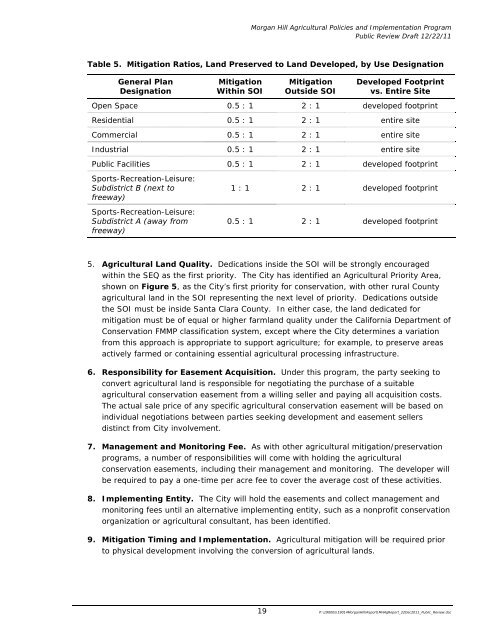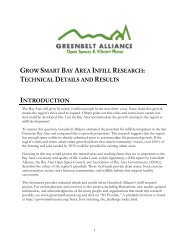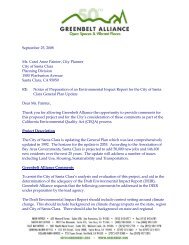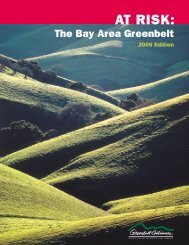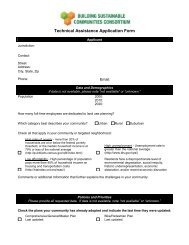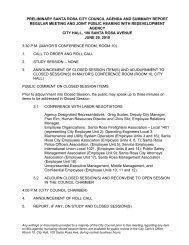Morgan Hill Agricultural Policies and Implementation Program
Morgan Hill Agricultural Policies and Implementation Program
Morgan Hill Agricultural Policies and Implementation Program
Create successful ePaper yourself
Turn your PDF publications into a flip-book with our unique Google optimized e-Paper software.
<strong>Morgan</strong> <strong>Hill</strong> <strong>Agricultural</strong> <strong>Policies</strong> <strong>and</strong> <strong>Implementation</strong> <strong>Program</strong><br />
Public Review Draft 12/22/11<br />
Table 5. Mitigation Ratios, L<strong>and</strong> Preserved to L<strong>and</strong> Developed, by Use Designation<br />
General Plan<br />
Designation<br />
Mitigation<br />
Within SOI<br />
Mitigation<br />
Outside SOI<br />
Developed Footprint<br />
vs. Entire Site<br />
Open Space 0.5 : 1 2 : 1 developed footprint<br />
Residential 0.5 : 1 2 : 1 entire site<br />
Commercial 0.5 : 1 2 : 1 entire site<br />
Industrial 0.5 : 1 2 : 1 entire site<br />
Public Facilities 0.5 : 1 2 : 1 developed footprint<br />
Sports-Recreation-Leisure:<br />
Subdistrict B (next to<br />
freeway)<br />
Sports-Recreation-Leisure:<br />
Subdistrict A (away from<br />
freeway)<br />
1 : 1 2 : 1 developed footprint<br />
0.5 : 1 2 : 1 developed footprint<br />
5. <strong>Agricultural</strong> L<strong>and</strong> Quality. Dedications inside the SOI will be strongly encouraged<br />
within the SEQ as the first priority. The City has identified an <strong>Agricultural</strong> Priority Area,<br />
shown on Figure 5, as the City’s first priority for conservation, with other rural County<br />
agricultural l<strong>and</strong> in the SOI representing the next level of priority. Dedications outside<br />
the SOI must be inside Santa Clara County. In either case, the l<strong>and</strong> dedicated for<br />
mitigation must be of equal or higher farml<strong>and</strong> quality under the California Department of<br />
Conservation FMMP classification system, except where the City determines a variation<br />
from this approach is appropriate to support agriculture; for example, to preserve areas<br />
actively farmed or containing essential agricultural processing infrastructure.<br />
6. Responsibility for Easement Acquisition. Under this program, the party seeking to<br />
convert agricultural l<strong>and</strong> is responsible for negotiating the purchase of a suitable<br />
agricultural conservation easement from a willing seller <strong>and</strong> paying all acquisition costs.<br />
The actual sale price of any specific agricultural conservation easement will be based on<br />
individual negotiations between parties seeking development <strong>and</strong> easement sellers<br />
distinct from City involvement.<br />
7. Management <strong>and</strong> Monitoring Fee. As with other agricultural mitigation/preservation<br />
programs, a number of responsibilities will come with holding the agricultural<br />
conservation easements, including their management <strong>and</strong> monitoring. The developer will<br />
be required to pay a one-time per acre fee to cover the average cost of these activities.<br />
8. Implementing Entity. The City will hold the easements <strong>and</strong> collect management <strong>and</strong><br />
monitoring fees until an alternative implementing entity, such as a nonprofit conservation<br />
organization or agricultural consultant, has been identified.<br />
9. Mitigation Timing <strong>and</strong> <strong>Implementation</strong>. <strong>Agricultural</strong> mitigation will be required prior<br />
to physical development involving the conversion of agricultural l<strong>and</strong>s.<br />
19 P:\19000s\19014<strong>Morgan</strong><strong>Hill</strong>\Report\MHAgReport_22Dec2011_Public_Review.doc


